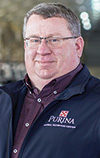Heat stress has a significant negative impact on milk production and the dairy cow’s immune system, weakening her defenses against a myriad of metabolic diseases and infections. The sooner you begin planning for heat stress instead of waiting for hot, humid summer weather, the better your herd will be prepared.
To mediate this environmental stress, it is vital to keep cows more comfortable, which improves dry matter intake and optimizes milk production and quality during stressful periods. Cows alleviate heat stress using a number of physiological changes, which include:
- Increased respiration rate (or breaths per minute)
- Increased sweating
- Increased blood flow to areas away from the body core
- Reduced feed intake (by as much as 30 percent)
- Metabolism changes (both at the cellular level and at the whole-animal level)
Effective strategies to mitigate heat stress should focus on these basic changes. Consider the following three strategies to improve cow comfort during hot and humid conditions and to maintain, or at least minimize, changes in milk quality and quantity.
1.Provide shade, water and fans
Providing shade is the least expensive and most effective way of reducing solar radiation caused by direct sunlight. However, shade is often not enough. The application of water to the skin surface will help with evaporative heat loss from the skin, providing a cooling effect.
Cattle should be wetted thoroughly and then allowed to dry off with the use of air movement, usually fans. Several cycles per hour of wetting and evaporating the water work best.
In humid regions, using a fog or mist will actually trap heat on the cows’ skin and exacerbate heat stress. Similarly, simply blowing fans on cattle once the ambient temperature has surpassed their body temperature (101.3ºF) will simulate a convection oven more than a cooling device.
Cows under fans with hot air blowing on them could actually succumb to heat stress as dehydration takes place.
In the weeks and months leading up to heat-stress season, it’s imperative to do preventative maintenance on all fans, sprinklers, soakers or evaporative cooling systems.
2.Consider facility design
Holding areas should be one of the greatest areas of opportunity for reducing heat stress. These areas need to be designed to avoid overcrowding in warm weather and to have sufficient air flow to allow for the evaporation of sweat or water applied to the cattle.
Thoroughly wetting cattle in the exit lane and providing fresh water access at this point can keep the cow cooler as she returns to the feeding area.
Water sprinklers over feeding lanes are common to encourage cattle to maintain dry matter intake. This system can work very well; however, care needs to be taken to avoid over-wetting the rations in the bunk if windy conditions blow the water onto the feed.
3.Evaluate the ration
In addition to physical methods of reducing heat stress, producers and their nutritionists can employ a number of nutritional strategies to maximize energy intake during periods of high heat and humidity, including:
- Increase the energy density of the ration to reduce gut fill and reduce the heat of fermentation.
- Provide high-quality forages.
- Alter feeding times to allow more feed intake when it’s cooler.
- Use TMRs to reduce feed sorting by cattle.
- Consider commercial feed supplements that improve rumen function and health during stressful time periods.
Work with your nutritionist to evaluate your ration and plan ahead for changes during heat-stress season. Dairy producers considering new or novel nutritional strategies to support health and immune function should ask for a review of supporting research before making a final decision.
Heat-stress season will be here soon. Take the necessary steps now to plan ahead to offset the rise in temperatures and humidity. Your cows will be more comfortable, more healthy and more productive. PD
Troy Wistuba, Ph.D., PAS, is a dairy technology manager for Phibro Animal Health Corporation. He’s a former animal science professor and specializes in working with producers, nutritionists and veterinarians to meet the nutritional needs of dairy cattle.






